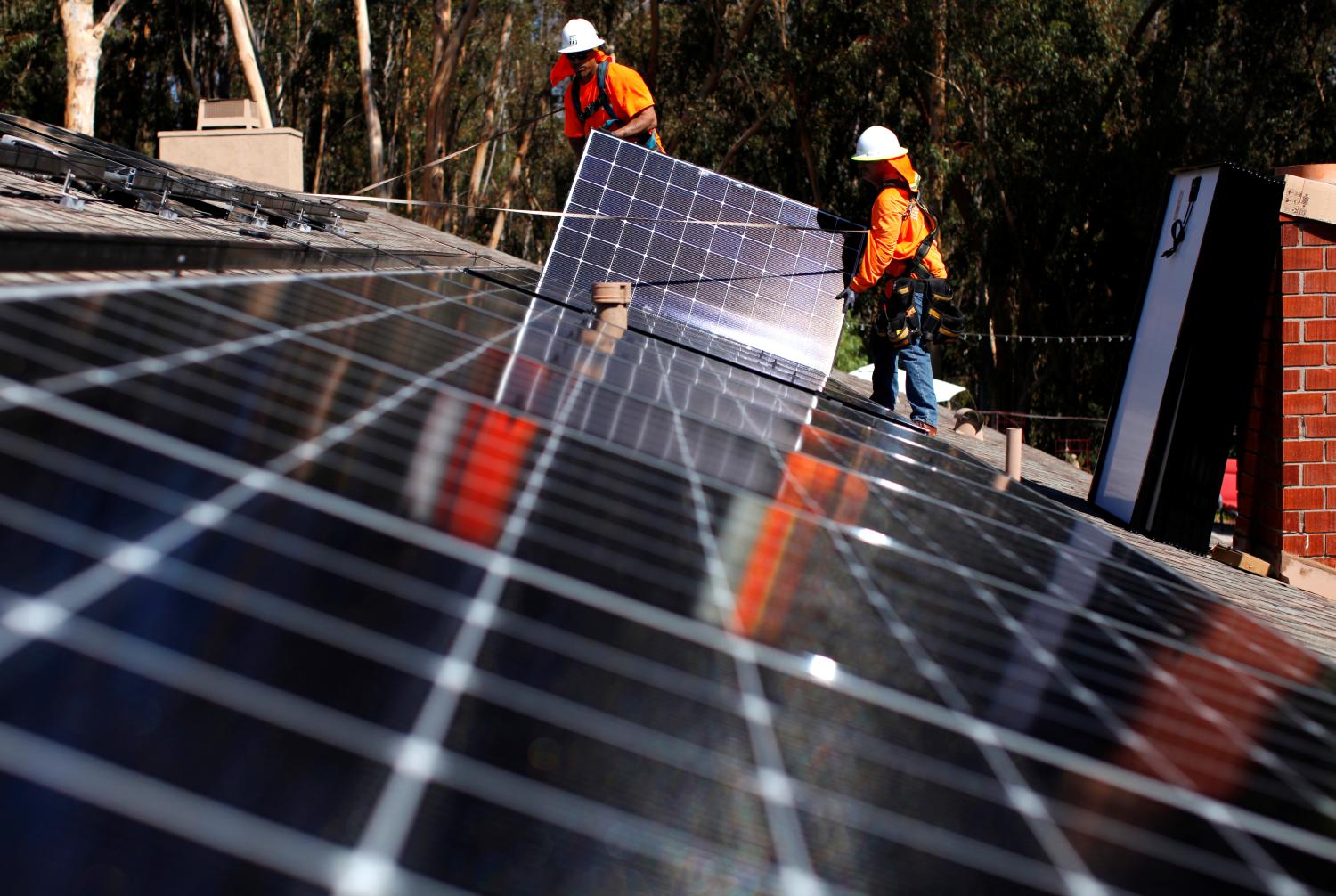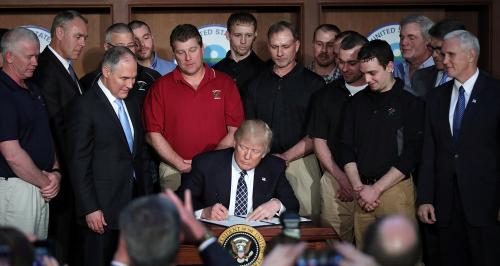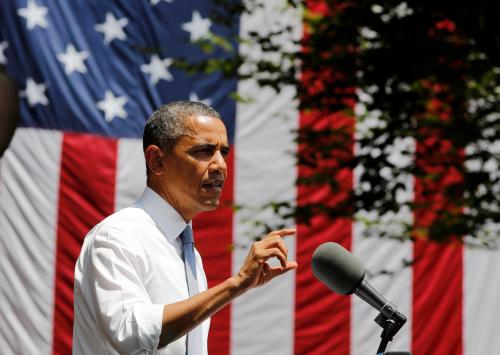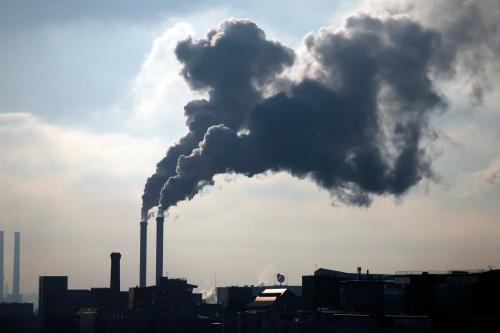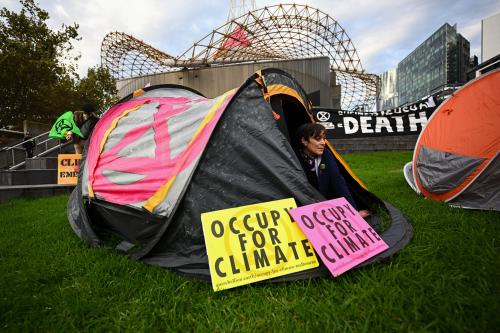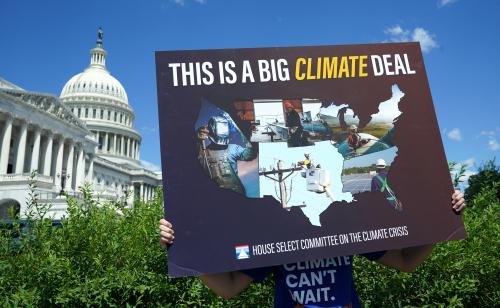The following brief is part of Brookings Big Ideas For America—an institution-wide initiative in which Brookings scholars have identified the biggest issues facing the country and provide ideas for how to address them. (Updated January 27, 2017)
The incoming administration has sent generally negative but confused signals on climate and energy, ranging from President-elect Donald Trump’s early assertion that he would cancel the Paris Agreement to his postelection comment that he is keeping an open mind about it.1 While it is still too early to predict how the next administration will engage the issue, a few options for Trump’s administration are as follows. The first, and least likely, option would be to pursue a continuation of the Obama administration’s regulatory strategy; second would be the “open mind” strategy of continuing international engagement to ensure American interests are represented alongside those of China and the EU; third would be working with Congress on supporting budgetary priorities and developing new legislative approaches to drive down emissions. Actions could include a tax reform and carbon pricing strategy, new investments in forests and other land-sector activities, and continued support for energy research and development, job training (or retraining), and finance and development aid for sustainable infrastructure for the poorest countries.
Regardless of how he chooses to proceed, engagement by President-elect Trump over the next four years is important for three overarching reasons.
Timeframe Closing
First, the window for action to keep a lid on climate change is closing fast. Climate change is complex, with impacts felt at the local and regional levels that are often removed in time and space from their root causes. But ultimately, the science is clear regarding the basic cause-and-effect relationship that links emissions of greenhouse gases (GHGs) to a kind of “loading of the dice” that leads to increased temperatures, heat waves, droughts, floods, and other hazards. The globally agreed upon goal of keeping warming to no more than two degrees Celsius (2°C) above preindustrial levels will be difficult to secure. For reference, the world is now at about one degree of warming above preindustrial levels, and despite some recent slowing in the rate of change, our global economy is still producing large amounts of GHGs annually. Keeping warming under 2°C will require a rapid, near-term effort over approximately the next 10 to 15 years if we are to reach a peak in annual global GHG emissions and thereafter start a rapid decline. Without intensive reductions in the near term, by 2050 U.S. emissions would likely need to decrease by about 80 percent from 2005 levels.
The International Policy Framework
Second, the appropriate international policy framework is now established but must be made real through national actions and continued international engagement. The Paris Agreement solves a difficult problem: harnessing what is useful in international agreements—goal setting, facilitating transparency, and organizing a process for increasing ambition over time—to encourage substantive action at the national level. The solution depends on a division of effort whereby countries provide national targets based on their own internal assessments, and the international process can in turn reassure countries that the other major players are doing their fair share. This global process reflects American interests, so for the United States to walk away from it would leave an extraordinary amount of potentially helpful action on the part of other countries on the table.
Affordable—and Superior—Clean Technology
Third, clean technology costs are rapidly dropping and many are nearing, but not at, tipping points relative to legacy technologies. Many technologies, particularly those that are mass manufactured, become cheaper over time as more units are produced (think of computers and cell phones). Historically, clean technologies were at a market disadvantage for three reasons: (1) they were immature and therefore, as expected, more expensive; (2) the clean benefits of the technologies were not reflected in their market prices relative to legacy technologies; and (3) for some technologies, their capital structure was weighted toward more up-front investment relative to legacy technologies, which would often be cheaper up front and have higher long-term operating costs. Nonetheless, the costs of many clean technologies have dropped to levels that are competitive with and even lower than their legacy competitors. Since 2009, costs for solar and for energy-efficient LED lighting have dropped 70 percent and 90 percent, respectively. Wind technology saw costs drop by 40 percent. Rooftop solar is now nearing and in some places is cheaper than grid-connected pricing. Still, because the costs of dirtier technologies are still not captured in their prices, the United States will likely continue to overinvest in these dirty technologies.
Securing Action in Five Key Areas
We are currently the world’s second-largest emitter of GHGs, emitting roughly 5,800 million net tons of carbon dioxide (CO2) equivalent (MtCO2e) per year.
Continued engagement over the next four years is both in our own interests as well as right for the global climate. Recently, the United States has pursued a policy of integrating domestic actions with international leadership to encourage broad, global participation on climate change. We are currently the world’s second-largest emitter of GHGs, emitting roughly 5,800 million net tons of carbon dioxide (CO2) equivalent (MtCO2e) per year. China is the biggest emitter, having surpassed the United States about 10 years ago, and is now emitting roughly 10,500 MtCO2e per year. Other big emitters include the EU, India, Russia, Indonesia, Brazil, and Japan. Because the United States currently only emits about 13 percent of global GHGs, it cannot solve the problem alone. At the same time, though, others will be reluctant to act without full U.S. engagement. The United States is the top emitter among developed countries and is looked to for leadership in both policy and new clean energy technologies. For these reasons, the United States has pursued a policy of addressing domestic emissions and setting ambitious domestic targets, seeking to provide global leadership on what is fundamentally a collective action challenge. With this in mind, the Trump administration should pursue a set of initiatives that would collectively ensure action around five key areas.
-
Develop Great Infrastructure as Green Infrastructure
We all know that Donald Trump wants to Make America Great—he has talked about infrastructure and has made a career out of building things. As the next administration looks to enhance and expand American infrastructure, from transportation to power and more, it can note that the most impressive, forward-looking, modern, and job-creating infrastructure is often efficient and sustainable. Perhaps Trump could tour China and look at their high-speed rail (and even regular electric rail) network or go see the world’s biggest solar facility in Morocco. Trump is right that our infrastructure lags, but looking backward to the dirty and inefficient technologies of the 19th century would just make the United States look antiquated and uncompetitive.
-
Lead in Energy Innovation and Jobs
While the level of interest in the rest of the climate agenda remains uncertain at best, the incoming administration may continue to support new technologies that will enable the clean energy transition at lower costs and with better outcomes. The United States has an excellent system of higher education, national laboratories, and funding for science and technology research and strong capital markets as well as a risk culture that supports new ventures. Stimulating investment in new technologies requires a broad effort aimed at both bolstering basic research and development but also fostering private-sector innovation and creating stable and predictable markets for new technologies. In addition, the U.S. government promised to double its budget for clean energy research and development. It will also be important to take steps to ensure that workers in old industries like coal are not cast aside. Restructuring causes disruption to real lives and efforts should be undertaken to partner with universities and the private sector to ensure that those workers from old industries can find new uses for their skills.
-
Promote Regulatory Approaches that Make Sense
The U.S. national climate target submitted in advance of the Paris negotiations sets a goal of reducing emissions by 26 to 28 percent below 2005 levels by 2025. The core element of the Obama administration’s strategy was to implement existing U.S. law, such as the Clean Air Act or Energy Policy Act, in diverse sectors. This has led to a number of regulatory rulemakings over the past seven years that have focused on both CO2 and non-CO2 reductions. While Trump has made much of his interest in cutting regulations, many of the elements of the overall climate action plan are relatively mundane and end up both improving overall health and saving taxpayers and ratepayers money through energy efficiency. In addition, many of the regulations have long since been finalized and the new technologies are already being deployed. For example, once updated refrigerator or air conditioner efficiency standards are in place and new technologies are on the shelf, political benefits to rolling them back are virtually nonexistent. As such, a number of the programs included in the Obama climate action plan may well stay in place.
To lower carbon dioxide emissions from the U.S. energy system, which is the biggest source of our country’s emissions, the Obama administration finalized a few major rules that would have a big impact but have also been criticized by Trump. The Clean Power Plan (CPP) would accelerate the decarbonization of the U.S. electricity grid through increased use of renewables and natural gas.2 But recent indications show that market forces are at least as great, if not a greater, than forces accelerating the transition.
Another lower profile set of rules governs fuel efficiency in vehicles and accounts for close to the same volume of emissions reductions by 2030 as the CPP. Last but not least are energy efficiency standards promulgated by the Department of Energy (21 new standards were set since 2013 alone). These collectively should reduce about 3,000 MtCO2e by 2030—nearly half of what either the CPP or the transportation efficiency standards are likely to deliver individually. In addition to regulations aimed at energy CO2, several other policies are designed to tackle non-CO2 gases such as methane or hydrofluorocarbons (HFCs). At the federal level, these have included actions through tax policy to support deployment of solar and wind energy and initiation of voluntary measures and public-private partnerships in areas such as land use, agriculture, and forestry. These federal initiatives coexist with a patchwork of policies at the state and even local level to encourage deployment of clean technologies and, in some cases, pricing of emissions (such as California’s emissions trading system).
These many policies provide a strong foundation for the United States to reach its domestic 2020 and 2025 emissions goals. Ten years ago, projections for the United States estimated that emissions would be about 20 percent above 2005 levels by 2020. It now looks likely that the United States will be in the range of 17 percent below 2005 levels by 2020, which means we should be able to reach the 2020 target established in 2009. Such actions are part of a sound overall strategy to ensure global cooperation on the issue. However, reaching goals for 2025 and creating the conditions to continue lowering emissions at roughly the same rate through 2030 and beyond constitute a multipart challenge for the Trump administration. The United States can continue to support an approach of reasonable regulations in areas that support energy efficiency, renewables, and reduction in short-lived climate pollutants. In other words, drawing on existing law and using robust regulatory processes to establish reasonably cost-effective pathways for reducing emissions will be a savvy way forward and will preserve America’s aspiration to be a leader on climate as well as on clean energy and sustainable infrastructure.
To this end, the Trump administration should impartially consider the regulatory actions that have not yet been finalized, such as for existing oil and gas methane sources. Second, the next administration should continue to pursue options for reducing emissions through voluntary means, including via partnerships with affected industries, and through support of city- and state-level initiatives. Third, while the regulatory approach is a solid way to deliver reductions through 2025 and beyond, there is a strong case to be made for setting a price on emissions, which can be a more efficient way of raising revenue than corporate or income taxes. Pricing can happen via a carbon tax or a cap-and-trade system, but the key element, as mentioned above, is to improve the visibility of the costs of dirty technologies in investment decisions. States have the power to initiate pricing, and regulatory actions can establish a pricing system in certain circumstances. A vital first step toward this will be for Congress to establish a pricing policy that would encourage faster deployment of clean technologies, above and beyond regulatory actions.
-
Establish a Viable Pathway to Midcentury Deep Decarbonization
Given the structure of the energy economy, achieving major cuts on the order of 80 percent by 2050 will require a few broad measures. They include steps to decarbonize electricity, undertake massive energy efficiency reforms, switch as much demand as possible to electricity, and bolster carbon sinks as much as possible. Getting there requires connecting what we know about the future constraints to existing investment decisions—particularly those that have long lifespans. While a car may be replaced a couple of times before 2050, most industrial plants, buildings, and electricity generators will at most be replaced once. Moreover, the United States cannot easily reach its goals without healthy and growing forests and other carbon sinks; a major commitment to invest in and expand forests could help significantly in the post-2030 period. Even in the absence of a strong commitment to near-term action, the next administration can ensure that there is sufficient modeling and analytical capacity to understand all aspects of our emissions trajectory, including assessing potential land-sector sinks. We should in turn apply insights from this planning process to set medium-term policies and make the infrastructure investments needed to achieve deep decarbonization by midcentury.
-
Stay Engaged in the Paris Process
Because of the centrally important role of national targets and transparency embodied in the Paris Agreement, the United States should support countries in their efforts to reach their own ambitious targets. This can take the form of public-private partnerships for investment, facilitating improvement of national analytical capacity and techniques, and financing available through existing mechanisms (for example, bilateral partnerships, the World Bank, or the Green Climate Fund).
The United States should continue advocating for knowledge sharing, including by supporting and encouraging the international community to create a robust platform for transparency under the Paris Agreement. While not the only, or the most important, reason for continued engagement, China does remain committed to continuing climate action and could leverage nonparticipation by the United States to further its own agenda. On November 17, Liu Zhenmin, China’s representative at the Marrakech climate conference, noted widespread concerns about a U.S. retreat on climate change. He signaled that, with or without the United States, China intends to be a frontrunner on climate action, partnering with other nations on adaptation to rising climate risks, public-private partnership investments in sustainable infrastructure, and more. China would certainly intend to use nonparticipation by the United States in contrast to the rest of the world to show who is the greater superpower—in China’s argument, funding climate resilience in other countries and undertaking serious retooling of its energy economy demonstrates that China is moving ahead while the United States is returning to the 19th century.
Finally, the administration can continue to drive forward with other approaches to reducing short-lived climate pollutants that have other benefits, such as HFCs through the Montreal Protocol, methane through the Global Methane Initiative, and black carbon through the Arctic Black Carbon Initiative, collaborate on kerosene wick lamp dependence reduction, and participate in initiatives on climate-smart agriculture to reduce methane and nitrous oxide emissions.
While other countries have already decided to continue climate action for their own reasons, the Trump administration can nevertheless support a global approach to addressing climate change and keeping warming to lower-risk levels.
While other countries have already decided to continue climate action for their own reasons, the Trump administration can nevertheless support a global approach to addressing climate change and keeping warming to lower-risk levels. Laid out above are five areas for particular focus as well as steps that need to be activated over the next four years. But to deliver the level of change needed, we must transform the politics of climate action. Environmental policy has not always been a one-party issue, nor should it be. The Environmental Protection Agency was initiated under former president Richard Nixon and the Clean Air Act amendments of 1990 were ushered in under former president George H.W. Bush. Climate change affects the health and well-being of all Americans. Resilience and preparedness for natural hazards and extreme weather are concepts that all Americans can support. Affordable clean energy is a positive choice.
A recent study by the University of Maryland’s Program for Public Consultation found that 71 percent of respondents nationwide either strongly or somewhat strongly approve of a 2 percent annual emissions reduction goal.3 That approval rating included more than half of Republican respondents (52 percent). Broken out by state, the researchers found support among 66 percent of respondents in Ohio, 69 percent in Oklahoma, 70 percent in Texas, and 71 percent in Florida. Seen in light of polarized attitudes, these results may seem surprising, but given the nature of the issue, the Trump administration may find value in some initiatives that garner broad support, such as job retraining for many coal industry jobs that are almost certainly not coming back. Undoubtedly, stronger bipartisan engagement will be helpful for the long-term robustness of a long-term U.S. strategy to address climate change.
At present, the unknowns regarding how President-elect Donald Trump will address energy and climate greatly outweigh the knowns. Undoubtedly there will continue to be action at the international level, with or without the United States, and at the level of individual states and municipalities. The market forces pushing the U.S. energy mix away from coal and toward renewables and gas are not something that Trump can control. But Trump may find that supporting aspects of the international approach to climate change could provide diplomatic as well as economic dividends that clearly serve American interests. Indeed, it may soon emerge that opportunities for sustainable infrastructure and clean energy fit well into Trump’s still-evolving vision for the future.
-
Footnotes
- “Framework Convention on Climate Change,” United Nations, http://unfccc.int/paris_agreement/items/9485.php.
- “Clean Power Plan for Existing Power Plants,” U.S. Environmental Protection Agency, www.epa.gov/cleanpowerplan/clean-power-plan-existing-power-plants.
- Steven Kull, Clay Ramsay, Evan Lewis, and Antje Williams, Considering the Costs of Clean: Americans on Energy, Air Quality and Climate, Voice of the People and University of Maryland’s Program for Public Consultation, May 2016, www.cissm.umd.edu/sites/default/files/Considering%20the%20Cost%20of%20Clean%20-%20050416.pdf.

